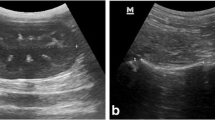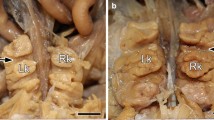Summary
Morphometric analyses have been used to study the renal pelvises of four common rodents: laboratory rat (R), hamster (H), gerbil (M), sand rat (P). Measurements on photographs of serial sections were used to determine the 1) area of the outer kidney surface, 2) surface area of each kidney zone and hilum facing the pelvic space, 3) volume of the pelvic space, 4) volume of each kidney zone.
As a standard measure the total pelvic surface area (kidney zones plus hilum) of each species was expressed as a percent of its respective outer kidney surface area: R=25.0%, H=32.6%, M=48.7%, P=97.2%. The medullary tissue formed about 80% of the total pelvic surface area in each species while cortex and hilum formed the remaining 20%. The outer medulla had about twice as much surface area facing the pelvic urine as did the inner medulla. The amount of inner stripe of the outer medulla was greater than the outer stripe of the outer medulla as the following progression of ratios (mm2/mm2) shows: R=1.8, H=2.5, M=2.2, P=4.9.
When the volume of the pelvic space and each kidney zone of each species was compared to the total volume of the respective kidney as a standard measure, it was determined that 1) the pelvic space was small being less than 5% of the total kidney volume, 2) the cortex was the largest kidney zone in all species: R=69.6%, H=68.1%, M=69.9%, P=51.6%, 3) the outer medulla was intermediate: R=25.8%, H=27.4%, M=23.1%, P=33.8%, 4) the inner medulla formed the smallest tissue zone in all species but was noticeably larger in P (10.7%) in comparison to the values for R=2.1%, H=2.5% and M=5.2%.
The simultaneous increases (from R to H to M to P) in: a) relative inner medullary volume, b) relative pelvic surface area, c) maximum urine concentrating capacity (Schmidt-Nielsen and O'Dell 1961; Munkasci and Miklos 1977) may support earlier hypotheses which suggest that a back diffusion of pelvic urine solutes augments medullary interstitial tonicity and thus is an intergral part of the urine concentrating mechanism.
Similar content being viewed by others
References
Bonventre JV, Lechene CP (1976) Effect of pelvic urine on renal concentrating ability. Fed Proc 35:372
Bonventre JV, Karnovsky MJ, Lechene CP (1978) Renal papillary epithelial morphology in antidiuresis and water diuresis. Am J Physiol 235:F69-F76
Boyarsky S, Labay P (1972) Uretral dynamics. In: Pathophysiology, drugs and surgical implications. Williams and Wilkins, Baltimore
Chuang EL, Reineck HS, Osgood RW, Kunau RT, Stein JH (1978) Studies on the mechanism of reduced urinary osmolality after exposure of the renal papilla. J Clin Invest 61:633–639
Del Tacca M, Lecchini S, Stacchini B, Tonini M, Frigo GM, Mazzonti L, Crema A (1974) Pharmacological studies of the rabbit and human renal pelvis. Naunyn-Schmiedeberg's Arch Pharmacol 285:209–222
Finberg JPM, Peart VS (1970) Function of smooth muscle of the rat renal pelvis. Response of the isolated pelvis muscle to angiotensin and some other substances. Brit J Pharmacol 39:373–381
Gertz K, Schmidt-Nielsen B, Pagel D (1966) Exchange of water, urea, and salt between the mammalian renal papilla and the surrounding urine. Fed Proc 25:327
Gosling JA, Wass ANC (1971) The behavior of the isolated rabbit renal calyx and pelvis compared with that of the ureter. Europ J Pharmacol 16:100–104
Gottschalk CW, Lassiter WE, Mylle, M, Ullrich KJ, Schmidt-Nielsen B, O'Dell R, Pehling G (1963) Micropuncture study of composition of loop of Henle fluid in desert rodents. Am J Physiol 204:532–535
Hicks RM (1966) The permeability of the rat transitional epithelium. J Cell Biol 28:21–31
Hyrtl J (1873) Die Corrosions-Anatomie und ihre Ergebnisse. Wilhelm Braumuller, Wien
Jamison RL, Buerkert J, Lacy F (1971) A micropuncture study of collecting tubule function in rats with hereditary diabetes insipidus. J Clin Invest 50:2444–2452
Jamison RL, Roinel N, de Rouffignac C (1979) Urinary concentrating mechanism in the desert rodent Psammomys obesus. Am J Physiol 236:F448-F453
Kaissling B, Kriz W (1979) Structural analysis of the rabbit kidney. Adv Anat Embryol Cell Biol 56:1–123
Kaissling B, de Rouffignac C, Barrett JM, Kriz W (1975) The structural organization of the kidney of the desert rodent Psammomys obesus. Anat Embryol 148:121–143
Lacy E (1980) Comparative renal anatomy: Application of morphometric techniques to determine surface area and volume. Contrib Nephrol 19 (in press)
Lacy E, Schmidt-Nielsen B (1979a) Anatomy of the renal pelvis in the hamster. Am J Anat 154:291–320
Lacy E, Schmidt-Nilesen B (1979b) Ultrastructural organization of the hamster renal pelvis. Am J Anat 155:403–424
Munkasci I, Miklos P (1977) Measurements on the kidneys and vasa recta of various mammals in relation to urine concentrating capacity. Acta Anat 98:456–468
Muschat M (1929) The effect of temperature and drugs on the spiral muscle of the renal papilla. J Pharmacol Exp Ther 37:297–308
Narath PA (1951) Renal pelvis and ureter. Grune and Stratton, New York
Pfeiffer E (1968) Comparative anatomical observations of the mammalian renal pelvis and medulla. J Anat 102:321–331
Pfeiffer E (1970) Ecological and anatomical factors affecting the gradient of urea and nonurea solutes in mammalian kidneys. In: Urea and the kidney, 358–365. Excerpta Medica Foundation, Amsterdam
Schmidt-Nielsen B (1969) The renal excretion of nitrogen containing metabolites. In: Progress in Nephrology, 1–12. Springer Verlag, Berlin-Heidelberg-New York
Schmidt-Nielsen B (1977) Excretion in mammals: role of the renal pelvis in modification of the urinary concentration and composition. Fed Proc 36:2493–2503
Schmidt-Nielsen B, O'Dell R (1961) Structure and concentrating mechansim in the mammalian kidney. Am J Physiol 200:1119–1124
Schütz W, Schnermann J (1972) Pelvic urine composition as a determinant of inner medullary solute concentration and urine osmolality. Pflügers Arch 334:154–166
Sperber I (1944) The mammalian kidney. Zool Bidr Uppsala 22:249–431
Steinhausen M (1964) In vivo-Beobachtungen an der Nierenpapille von Goldhamstern nach intravenöser Lissamingrun-Injection. Pflügers Arch 279:195–213
Valtin H (1977) Structural and functional heterogenity of mammalian nephrons. Am J Physiol 233: F491-F501
Author information
Authors and Affiliations
Additional information
Alexander von Humboldt Stipendiat
Rights and permissions
About this article
Cite this article
Lacy, E.R. The mammalian renal pelvis: Physiological implications from morphometric analyses. Anat Embryol 160, 131–144 (1980). https://doi.org/10.1007/BF00301856
Accepted:
Issue Date:
DOI: https://doi.org/10.1007/BF00301856




